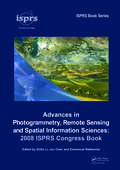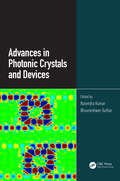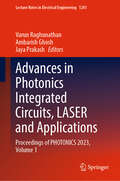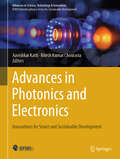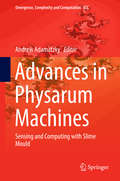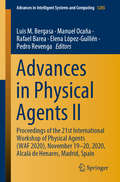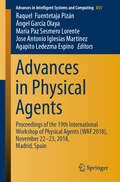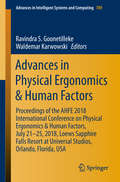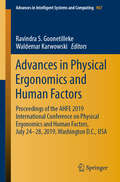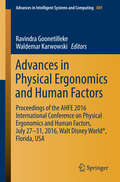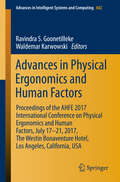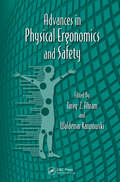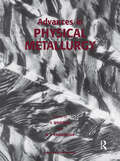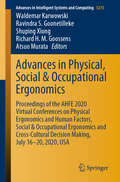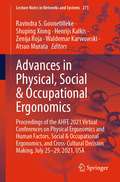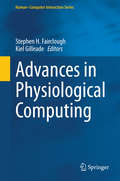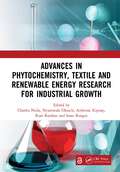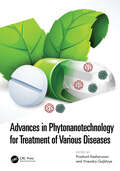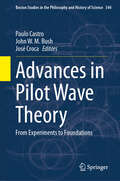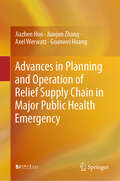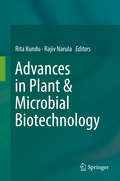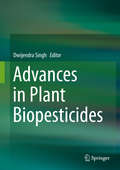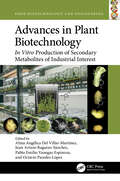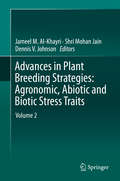- Table View
- List View
Advances in Photogrammetry, Remote Sensing and Spatial Information Sciences: 2008 ISPRS Congress Book (ISPRS Book Series)
by Jun Chen Zhilin Li Emmanuel BaltsaviasPublished on the occasion of the XXIst Congress of the International Society for Photogrammetry and Remote Sensing (ISPRS) in Beiijng, China in 2008, Advances in Photogrammetry, Remote Sensing and Spatial Information Sciences: 2008 ISPRS Congress Book is a compilation of 34 contributions from 62 researchers active within the ISPRS. The book covers
Advances in Photometric 3D-Reconstruction (Advances in Computer Vision and Pattern Recognition)
by Maurizio Falcone Jean-Denis Durou Yvain Quéau Silvia TozzaThis book presents the latest advances in photometric 3D reconstruction. It provides the reader with an overview of the state of the art in the field, and of the latest research into both the theoretical foundations of photometric 3D reconstruction and its practical application in several fields (including security, medicine, cultural heritage and archiving, and engineering). These techniques play a crucial role within such emerging technologies as 3D printing, since they permit the direct conversion of an image into a solid object. The book covers both theoretical analysis and real-world applications, highlighting the importance of deepening interdisciplinary skills, and as such will be of interest to both academic researchers and practitioners from the computer vision and mathematical 3D modeling communities, as well as engineers involved in 3D printing. No prior background is required beyond a general knowledge of classical computer vision models, numerical methods for optimization, and partial differential equations.
Advances in Photonic Crystals and Devices
by Narendra Kumar Bhuvneshwer SutharIn recent decades, there has been a phenomenal growth in the field of photonic crystal research and has emerged as an interdisciplinary area. Photonic crystals are usually nanostructured electromagnetic media consisting of periodic variation of dielectric constant, which prohibit certain electromagnetic wave frequency ranges called photonic bandgaps to propagate through them. Photonic crystals elicited numerous interesting features by unprecedented control of light and their exploitation is a promising tool in nanophotonics and designing optical components. The book ‘Advances in Photonic Crystals and Devices’ is designed with 15 chapters with introductory as well as research and application based contents. It covers the following highlighted features: Basics of photonic crystals and photonic crystal fibers Different theoretical as well as experimental approaches Current research advances from around the globe Nonlinear optics and super-continuum generation in photonic crystal fibers Magnetized cold plasma photonic crystals Liquid crystal defect embedded with graphene layers Biophysics and biomedical applications as optical sensors Two-dimensional photonic crystal demultiplexer Optical logic gates using photonic crystals A large number of references The goal of this book is to draw the background in understanding, fabrication and characterization of photonic crystals using a variety of materials and their applications in design of several optical devices. Though the book is useful as a reference for the researchers working in the area of photonics, optical computing and fabrication of nanophotonic devices, it is intended for the beginners like students pursuing their masters’ degree in photonics.
Advances in Photonics Integrated Circuits, LASER and Applications: Proceedings of PHOTONICS 2023, Volume 1 (Lecture Notes in Electrical Engineering #1241)
by Jaya Prakash Varun Raghunathan Ambarish GhoshThis book presents the select proceedings of the Biennial Photonics Conference (Photonics 2023) held at IISc, Bengaluru on 5-8 July 2023. It covers topics across multiple areas of photonics, including established areas like optical communication and networks, quantum optics, non-linear and ultrafast photonics, nanophotonics, biophotonics and bioimaging, photonic integrated circuits, fibers and sensors, optical materials and fabrication techniques, optical metrology, and instrumentation, optofluidics, laser applications, optoelectronics. The book also covers emerging areas in photonics, such as THz photonics, structured Light, 2D materials, optomechanics, topological photonics, and AI/ML in photonics. The book will be useful for researchers and professionals interested in the broad field of photonics.
Advances in Photonics and Electronics: Innovations for Smart and Sustainable Development (Advances in Science, Technology & Innovation)
by Aavishkar Katti Ritesh Kumar ChourasiaThe book presents the collated and high-quality proceedings of the Conference on Recent Technologies in Electronics and Photonics held during 9-10 February 2024 at MIT-WPU, Pune, India. The main objective of this book is the introduction of recent innovations and current trends of photonics and electronics along with advanced device applications. Photonics and electronics together are shaping up to be the two main pillars of innovation for sustainable development and technological advances. The emphasis in this book will be on presenting recent application-based research in the mentioned fields rather than purely theoretical ideas. The readers will gain insights on recent innovations across many fields of photonics on one hand: laser science and nonlinear optics, photonic materials, nanophotonics, solar photovoltaics, optoelectronics, green photonics, and fiber optics and a diverse set of topics in electronics on the other: Semiconductor Electronics, Electronic Materials, Microelectronics, AI/ML, Internet of Things etc. The book is useful for early career researchers in Science and Engineering, as also university professors and industry professionals.
Advances in Physarum Machines: Sensing and Computing with Slime Mould (Emergence, Complexity and Computation #21)
by Andrew AdamatzkyThis book is devoted to Slime mould Physarumpolycephalum, which is a large single cell capable for distributed sensing,concurrent information processing, parallel computation and decentralizedactuation. The ease of culturing and experimenting with Physarum makes thisslime mould an ideal substrate for real-world implementations of unconventionalsensing and computing devices The book is a treatise of theoretical and experimentallaboratory studies on sensing and computing properties of slime mould, and onthe development of mathematical and logical theories of Physarum behavior. It is shown how to make logical gates and circuits,electronic devices (memristors, diodes, transistors, wires, chemical andtactile sensors) with the slime mould. The book demonstrates how to modifyproperties of Physarum computing circuits with functional nano-particles andpolymers, to interface the slime mould with field-programmable arrays, and touse Physarum as a controller of microbial fuel cells. A unique multi-agent model of slime is shown to servewell as a software slime mould capable for solving problems of computationalgeometry and graph optimization. The multiagent model is complemented bycellular automata models with parallel accelerations. Presented mathematical modelsinspired by Physarum include non-quantum implementation of Shor'sfactorization, structural learning, computation of shortest path tree ondynamic graphs, supply chain network design, p-adic computing and syllogisticreasoning. The book is a unique composition of vibrant andlavishly illustrated essays which will inspire scientists, engineers andartists to exploit natural phenomena in designs of future and emergentcomputing and sensing devices. It is a 'bible' of experimental computing withspatially extended living substrates, it spanstopics from biology of slime mould, to bio-sensing, tounconventional computing devices and robotics, non-classical logics and music and arts.
Advances in Physical Agents II: Proceedings of the 21st International Workshop of Physical Agents (WAF 2020), November 19-20, 2020, Alcalá de Henares, Madrid, Spain (Advances in Intelligent Systems and Computing #1285)
by Luis M. Bergasa Manuel Ocaña Rafael Barea Elena López-Guillén Pedro RevengaThe book reports on cutting-edge Artificial Intelligence (AI) theories and methods aimed at the control and coordination of agents acting and moving in a dynamic environment. It covers a wide range of topics relating to: autonomous navigation, localization and mapping; mobile and social robots; multiagent systems; human-robot interaction; perception systems; and deep-learning techniques applied to the robotics. Based on the 21st edition of the International Workshop of Physical Agents (WAF 2020), held virtually on November 19-20, 2020, from Alcalá de Henares, Madrid, Spain, this book offers a snapshot of the state-of-the-art in the field of physical agents, with a special emphasis on novel AI techniques in perception, navigation and human robot interaction for autonomous systems.
Advances in Physical Agents: Proceedings of the 19th International Workshop of Physical Agents (WAF 2018), November 22-23, 2018, Madrid, Spain (Advances in Intelligent Systems and Computing #855)
by Raquel Fuentetaja Pizán Ángel García Olaya Maria Paz Sesmero Lorente Jose Antonio Iglesias Martínez Agapito Ledezma EspinoThe book reports on cutting-edge theories and methods aimed at the control and coordination of agents acting and moving in a dynamic environment. It covers a wide range of systems, including multiagent systems, domotic agents, robotic manipulators, soccer robots, autonomous and semiautonomous robots, as well as systems for industrial applications. Advances in software agents, sensors, computer visions and other related areas are also thoroughly discussed and presented in detail. Based on the 19th edition of the International Workshop of Physical Agents (WAF 2018), held on November 22-23, 2018, in Madrid, Spain, this book offers a snapshot of the state-of-the-art in the field of physical agents, with a special emphasis on autonomous systems such as mobile robots, industrial process or other complex systems.
Advances in Physical Ergonomics & Human Factors: Proceedings of the AHFE 2018 International Conference on Physical Ergonomics & Human Factors, July 21-25, 2018, Loews Sapphire Falls Resort at Universal Studios, Orlando, Florida, USA (Advances in Intelligent Systems and Computing #789)
by Waldemar Karwowski Ravindra S. GoonetillekeThis book reports on the state of the art in physical ergonomics and addresses the design of products, processes, services, and work systems to ensure they are productive, safe, and enjoyable for people to use. The human body’s responses to physical and physiological work demands, strain injuries from repetition, vibration, force, and posture are the most common types of issues examined, along with their design implications. The book explores a wide range of topics in physical ergonomics, including the consequences of repetitive motion, materials handling, workplace safety, the usability of portable devices, design, working postures, and the work environment. Mastering physical ergonomics and safety engineering concepts is fundamental to creating products and systems that people can safely and conveniently use, as well as avoiding stresses and minimizing the risk of accidents. Based on the AHFE 2018 Conference on Physical Ergonomics and Human Factors, held on July 21–25, 2018, in Orlando, Florida, USA, this book provides readers with a comprehensive perspective on the current challenges in physical ergonomics, which is a critical aspect in the design of any human-centered technological system, and for factors influencing human performance.
Advances in Physical Ergonomics and Human Factors: Proceedings Of The Ahfe 2017 Conference On Physical Ergonomics And Human Factors, July 17-21, 2017, Los Angeles, California, Usa (Advances in Intelligent Systems and Computing #602)
by Waldemar Karwowski Ravindra S. GoonetillekeThis book reports on the state of the art in physical ergonomics and is concerned with the design of products, process, services, and work systems to assure their productive, safe, and satisfying use by people. With focus on the human body's responses to physical and physiological work demands, repetitive strain injuries from repetition, vibration, force, and posture are the most common types of issues examined, along with their design implications. The book explores a wide range of topics in physical ergonomics, which includes the consequences of repetitive motion, materials handling, workplace safety, and usability in the use of portable devices, design, working postures, and the work environment. Mastering physical ergonomics and safety engineering concepts is fundamental to the creation of products and systems that people are able to use, as well as the avoidance of stresses and minimization of the risk of accidents. Based on the AHFE 2016 International Conference on Physical Ergonomics & Human Factors, held on July 27-31, 2016 in Walt Disney World®, Florida, USA, the book provides readers with a comprehensive view of the current challenges in Physical Ergonomics, which are a critical aspect in the design of any human-centered technological system, and factors influencing human performance.
Advances in Physical Ergonomics and Human Factors: Proceedings of the AHFE 2016 International Conference on Physical Ergonomics and Human Factors, July 27-31, 2016, Walt Disney World®, Florida, USA (Advances in Intelligent Systems and Computing #489)
by Ravindra Goonetilleke Waldemar KarwowskiTaking the field of human factors and ergonomics beyond state of the art, this volume focuses on advances in the use of ergonomics modeling and on the evaluation of usability, which is a critical aspect of any human-technology system. The research described in the book's 70 chapters is an outcome of dedicated research by academics and practitioners from around the world, and across disciplines. The chapters are organized under five sections: I. Models and Methods II. Vision and Visual Displays , III. Product Design and User Interfaces IV. Input Devices and Computer Based Systems V. Individual and Environmental Technology Related Issues. This work provides an invaluable resource for evaluating products and environments and designing future ones that are intuitive, safe, and easy to use. Seven other titles in the Advances in Human Factors and Ergonomics Series are: Advances in Human Factors and Ergonomics in Healthcare Advances in Applied Digital Human Modeling Advances in Cross-Cultural Decision Making Advances in Cognitive Ergonomics Advances in Occupational, Social and Organizational Ergonomics Advances in Human Factors, Ergonomics and Safety in Manufacturing and Service Industries Advances in Neuroergonomics and Human Factors of Special Populations
Advances in Physical Ergonomics and Human Factors: Proceedings of the AHFE 2017 International Conference on Physical Ergonomics and Human Factors, July 17-21, 2017, The Westin Bonaventure Hotel, Los Angeles, California, USA (Advances in Intelligent Systems and Computing #602)
by Waldemar Karwowski Ravindra S. GoonetillekeThis book reports on the state of the art in physical ergonomics and is concerned with the design of products, process, services, and work systems to assure their productive, safe, and satisfying use by people. With focus on the human body's responses to physical and physiological work demands, repetitive strain injuries from repetition, vibration, force, and posture are the most common types of issues examined, along with their design implications. The book explores a wide range of topics in physical ergonomics, which includes the consequences of repetitive motion, materials handling, workplace safety, and usability in the use of portable devices, design, working postures, and the work environment. Mastering physical ergonomics and safety engineering concepts is fundamental to the creation of products and systems that people are able to use, as well as the avoidance of stresses and minimization of the risk of accidents. Based on the AHFE 2016 International Conference on Physical Ergonomics & Human Factors, held on July 27-31, 2016 in Walt Disney World#65533;, Florida, USA, the book provides readers with a comprehensive view of the current challenges in Physical Ergonomics, which are a critical aspect in the design of any human-centered technological system, and factors influencing human performance.
Advances in Physical Ergonomics and Safety (Advances in Human Factors and Ergonomics Series)
by Waldemar Karwowski Tareq Z. AhramBased on recent research, this book discusses physical ergonomics, which is concerned with human anatomical, anthropometric, physiological and biomechanical characteristics as they relate to physical activity. Topics include working postures, materials handling, repetitive movements, work-related musculoskeletal disorders, workplace layout, safety,
Advances in Physical Metallurgy
by Anirban BanerjeeThis volume focuses on the wealth of existing literature on physical metallurgy, and deals with materials in different states of order and the process of order evolution. It is a valuable reference by students and researchers in the field of materials science and metallurgy.
Advances in Physical, Social & Occupational Ergonomics: Proceedings of the AHFE 2020 Virtual Conferences on Physical Ergonomics and Human Factors, Social & Occupational Ergonomics and Cross-Cultural Decision Making, July 16–20, 2020, USA (Advances in Intelligent Systems and Computing #1215)
by Waldemar Karwowski Richard H. M. Goossens Ravindra S. Goonetilleke Atsuo Murata Shuping XiongThis book reports on cutting-edge findings and developments in physical, social and occupational ergonomics. It covers a broad spectrum of studies and evaluation procedures concerning physical and mental workload, work posture and ergonomic risk. Further, it reports on significant advances in the design of services and systems, including those addressing special populations, for purposes such as health, safety and education, and discusses solutions for a better and safer integration of humans, automated systems and digital technologies. The book also analyzes the impact of culture on people’s cognition and behavior, providing readers with timely insights into theories on cross-cultural decision-making, and their diverse applications for a number of purposes in businesses and societies. Based on three AHFE 2020 conferences (the AHFE 2020 Virtual Conference on Physical Ergonomics and Human Factors, the AHFE 2020 Virtual Conference on Social & Occupational Ergonomics, and the AHFE 2020 Virtual Conference on Cross-Cultural Decision Making), it provides readers with a comprehensive overview of the current challenges in physical, social and occupational ergonomics, including those imposed by technological developments, highlights key connections between them, and puts forward optimization strategies for sociotechnical systems, including their organizational structures, policies and processes.
Advances in Physical, Social & Occupational Ergonomics: Proceedings of the AHFE 2021 Virtual Conferences on Physical Ergonomics and Human Factors, Social & Occupational Ergonomics, and Cross-Cultural Decision Making, July 25-29, 2021, USA (Lecture Notes in Networks and Systems #273)
by Waldemar Karwowski Ravindra S. Goonetilleke Atsuo Murata Shuping Xiong Henrijs Kalkis Zenija RojaThis book reports on cutting-edge findings and developments in physical, social and occupational ergonomics. It covers a broad spectrum of studies and evaluation procedures concerning physical and mental workload, work posture and ergonomic risk. Further, it reports on significant advances in the design of services and systems, including those addressing special populations, for purposes such as health, safety and education, and discusses solutions for a better and safer integration of humans, automated systems and digital technologies. The book also analyzes the impact of culture on people’s cognition and behavior, providing readers with timely insights into theories on cross-cultural decision-making, and their diverse applications for a number of purposes in businesses and societies. Based on the AHFE 2021 conferences on Physical Ergonomics and Human Factors, Social & Occupational Ergonomics, and Cross-Cultural Decision Making, held virtually on 25–29 July, 2021, from USA, it provides readers with a comprehensive overview of the current challenges in physical, social and occupational ergonomics, including those imposed by technological developments, highlights key connections between them, and puts forward optimization strategies for sociotechnical systems, including their organizational structures, policies and processes.
Advances in Physiological Computing (Human–Computer Interaction Series)
by Stephen H. Fairclough Kiel GilleadeThis edited collection will provide an overview of the field of physiological computing, i. e. the use of physiological signals as input for computer control. It will cover a breadth of current research, from brain-computer interfaces to telemedicine.
Advances in Phytochemistry, Textile and Renewable Energy Research for Industrial Growth: Proceedings of the International Conference of Phytochemistry, Textile and Renewable Energy for Sustainable development (ICPTRE 2020), August 12-14, Eldoret, Kenya
by Dr Charles NzilaThe International Conference on Phytochemistry, Textile, & Renewable Energy Technologies for Sustainable Development (ICPTRE 2020) was hosted by the World bank funded Africa Centre of Excellence in Phytochemicals, Textile and Renewable Energy (ACEII-PTRE) based at Moi University in conjunction with Donghua University, China and the Sino–Africa International Symposium on Textiles and Apparel (SAISTA). The theme of the conference was Advancing Science, Technology and Innovation for Industrial Growth. The research relationships between universities and industry have enabled the two entities to flourish and, in the past, have been credited for accelerated sustainable development and uplifting of millions out poverty. ICPTRE 2020 therefore provided a platform for academic researchers drawn from across the world to meet key industry professionals and actively share knowledge while advancing the role of research in industrial development, particularly, in the developing nations. The conference also provided exhibitors with an opportunity to interact with professionals and showcase their business, products, technologies and equipment. During the course of the conference, industrial exhibitions, research papers and presentations in the fields of phytochemistry, textiles, renewable energy, industry, science, technology, innovations and much more were presented.
Advances in Phytonanotechnology for Treatment of Various Diseases
by Prashant Kesharwani Virendra GajbhiyeSeveral plant bioactives or plant-derived therapeutic molecules have been used against life-threatening diseases and their nanoparticle-mediated delivery greatly improves therapeutic efficacy. Advances in Phytonanotechnology for Treatment of Various Diseases aims to describe past and recent advances achieved in the field of phytonanotechnology. The chapters of this book provide thorough knowledge of medicinal plants, plant bioactives, plant extract-based nanoparticle synthesis, delivery of plant bioactives through nanoparticles, and their therapeutic activity against life-threatening diseases. This book focuses on the therapeutic activity of phytocomponents present in plants from diverse families, genera, and species. The book also covers future aspects and challenges present in phytonanotechnology for curing human diseases. This book fulfils the thrust of researchers working in this field, which further encourages them to make new discoveries in this area and support the development of effective nanoparticle-mediated plant bioactive delivery platforms for treating human diseases. Key Features Provides information on medicinal plants and plant bioactives used in the treatment of various life-threatening diseases Covers green synthesis of nanoparticles as well as their toxicological and biological effects Explores various nanocarriers routinely used in the delivery of plant bioactives and their efficacy for future drug delivery Envisages future opportunities, challenges, and implementation made in phytonanotechnology-based treatment of human diseases
Advances in Pilot Wave Theory: From Experiments to Foundations (Boston Studies in the Philosophy and History of Science #344)
by Paulo Castro John W. M. Bush José CrocaThis book provides a state-of-the-art review of Pilot Wave Theory at the beginning of the XXI century. It contains the best contributions of the first International Conference on Advances in Pilot Wave Theory, held in Lisbon in 2021. The event brought together physicists from the new emerging field of Hydrodynamic Quantum Analogs (HQA) and philosophers of science. Three main themes were discussed: 1. Hydrodynamic quantum analogs, 2. Theoretical advances in pilot wave physics and, 3. Philosophical foundations of pilot wave theory. Recent experimental work in HQA has provided impetus to develop the pilot-wave approach into a realistic basis of quantum mechanics, specifically a dynamical completion of the existing theory of quantum statistics. To that end, the meeting featured theoretical work that advanced Louis de Broglie original pilot wave theory. This collection shows how several aspects of quantum systems have been reproduced in the hydrodynamic environment, and how the power of analogy suggests the possibility of a relatively intelligible quantum realm. Most notably, the notion of memory, as engendered in the pilot-wave-hydrodynamic system, suggests a profitable direction to explore in developing a more complete description of quantum phenomena. This book is expected to be of great interest to physicists, computer scientists and philosophers of science interested in the foundations of Quantum Mechanics. Chapter 1 and Chapter 12 are available open access under a Creative Commons Attribution 4.0 International License via link.springer.com.
Advances in Planning and Operation of Relief Supply Chain in Major Public Health Emergency
by Jianjun Zhang Jiazhen Huo Axel Werwatz Guanwei HuangWith Operations Research and System Dynamics as research tools, this book discusses the theme of emergency supplies in Major Public Health Emergency (MPHE) scenarios. The subject includes a series of new issues: critical criteria matching supply with demand for emergency supplies in MPHE, emergency medical materials reserve mode, dynamic optimization of emergency logistics, dynamic optimization of allocating multi-period and multi-category emergency supplies, etc. This book is suitable for university teachers, undergraduate and graduate students, and researchers in fields of logistics and supply chain management as well as emergency management. The most important features of this book include: Firstly, to achieve fairness and accuracy of material distribution during the epidemic, this book constructs a material shortage adjustment function. Secondly, from the comprehensive perspective of cross-regional coordination, multi-organization coordination and multiperiod coordination, the operation optimization models of emergency material supply in major epidemic situation are constructed. Additionally, the comparative analysis and empirical research of the practices in China and Germany also reflects the novelty and benefit of the book.
Advances in Plant & Microbial Biotechnology
by Rita Kundu Rajiv NarulaBiotechnology refers to the use or manipulation of an organism or parts of an organism. While the early applications were certainly simpler (though still relevant), modern plant biotechnology is primarily associated with molecular biology, cloning and genetic engineering. Over the last 50 years, several key discoveries have revolutionized the biological sciences and enabled the rapid growth of the biotechnology industry.This book gathers handpicked articles presented by national and international scientists at the International Conference on Biotechnology and Biological Sciences, BIOSPECTRUM 2017. It highlights the works of researchers and students in India and abroad on plant biotechnology and its applications in addressing various agricultural and food production-related issues.The respective papers explore a range of advances in plant biotechnology, e.g.: the cytotoxic potential of Moringaoleifera lam; the use of the entomo-pathogenic fungi Cordyceps sp. as unique and valuable sources of bioactive compounds; and strain improvement strategies for Cordyceps sp. In addition, they discuss the use of low-cost blue green algal biofertilizer comprising four blue green algal strains in rice fields; and the use of lignocellulosic materials as potential renewable energy resources for the production of fuels.This book will be extremely useful for researchers and students of biotechnology and plant science, providing an essential update on the latest findings and trends.
Advances in Plant Biopesticides
by Dwijendra SinghThe 'Advances in Plant Biopesticides' comprises 19 chapters on different important issues of developing biopesticides from promising botanicals and its phytomolecules based on the research reviews in the area concern. The book is written by reputed scientists and professors of both developed and developing countries namely Australia, Canada, Czech Republic, Egypt, Greece, India, Kenya, Thailand, Turkey, United Kingdom, and USA represented by almost 53 contributors. The book is organized and presented in such a form that the readers can acquire and enhance their knowledge in plant biopesticide bioresources, its application in different areas to manage pests and diseases of field crops, stored products with status of exploring in Africa, non-target effects on beneficial arthropods, control of arthropods of veterinary and vectors of communicable diseases, efficacy in controlling honeybee mite pests, prospect of applying new tools to enhance the efficacy of plant biopesticides through use of nanotechnology, most important plant derived active principle as source of biopesticides, possible mode of action of phytochemicals against arthropods, limitation, production status, consumption, formulation, registration and quality regulation of plant biopesticides and have been cited by important scientific references. Most importantly, the book also highlights a unique example for developing biopesticides based on the research on Annonaceae as potential source of plant biopesticide, exploiting phytochemicals for developing green technology for sustainable crop protection strategies to withstand climate change with example in Africa, and overview in developing insect resistance to plant biopesticides. Most of the chapter contributing authors are internationally reputed researchers and possess experiences of more than three to four decades in the area of plant biopesticides. The contributing and corresponding authors of the book - Advances in Plant Biopesticides proposed and identified by the editor (Dwijendra Singh) include distinguished professors and reputed scientists from different continents of the world namely MB Isman (Canada), Nadia Z Dimetry (Egypt), Zeaur R Khan (Kenya), John A Pickett (UK), Gadi VP Reddy (USA), S Gopalakrishnan (India), Anand Prakash (India), Chirantan Chattopadyay (India), Christos G Athanassiou (Greece), Philip C. Stevenson (UK), S Raguraman (India), S Ghosh (India), Mir S Mulla (USA), Apiwat Tawatsin (Thailand), Dwijendra Singh (India), K Sahayaraj (India), Suresh Walia (India), T Shivanandappa (India), Roman Pavela (Czeck Republic), Errol Hasan (Australia), Ayhan Gokce (Turkey), SK Raza (India), and their colleague co-contributors. This book would certainly provide the updated knowledge to global readers on plant biopesticides as one of the important reference source and would stimulate to present and future researchers, scientists, student, teachers, entrepreneurs, and government & non-government policy makers interested to develop new & novel environmentally safe plant biopesticides world over.
Advances in Plant Biotechnology: In Vitro Production of Secondary Metabolites of Industrial Interest (Food Biotechnology and Engineering)
by Alma Angélica Del Villar-Martínez, Juan Arturo Ragazzo-Sánchez, Pablo Emilio Vanegas-Espinoza, and Octavio Paredes-LópezThe goal of Advances in Plant Biotechnology is to integrate the most recent knowledge on tissue culture, secondary metabolites production under controlled conditions, scaling up to produce them at bioreactor level, and their industrial applications. The biosynthetic pathways and the factors that affect them and the accumulation of metabolites, including metabolomics in medicinal plants, are key components as well. Several extraction and encapsulation technological procedures are reviewed. The structure and function of metabolites from selected commercial crops are reported in detail. Finally, items of paramount importance, such as bioavailability and stability of metabolites in pharma and food products are deeply analyzed.Key Features: Strategies for obtaining selected metabolites through in vitro culture Application of biotechnological and bioengineering principles to the management of plant metabolites Description of the encapsulation of selected metabolites Bioavailability and stability of metabolites in pharma, food, and industrial sectors This book is mainly addressed to research scientists, technical staff, and private and public organizations involved in plant biotechnology and in its processing industries. Last, but not least, students at all levels and postdoctoral researchers have received special attention from all editors and authors in this publication.
Advances in Plant Breeding Strategies: Agronomic, Abiotic and Biotic Stress Traits
by Shri Mohan Jain Jameel M. Al-Khayri Dennis V. JohnsonThe basic concept of this book is to examine the use of innovative methods augmenting traditional plant breeding towards the development of new crop varieties under different environmental conditions to achieve sustainable food production. This book consists of two volumes: Volume 1 subtitled Breeding, Biotechnology and Molecular Tools and Volume 2 subtitled Agronomic, Abiotic and Biotic Stress Traits. This is volume 2 which contains 18 chapters highlighting breeding strategies for specific plant traits including improved nutritional and pharmaceutical properties as well as enhanced tolerance to insects, diseases, drought, salinity and temperature extremes expected under predicted global climate change.
